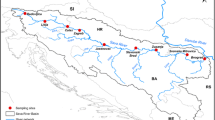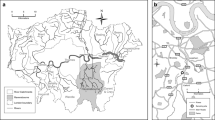Abstract
Data regarding trace element concentrations and fluxes in suspended sediments and bedload are scarce. To fill this gap and meet the international need to include polluted rivers in future world estimation of trace element fluxes, this study aimed to determine the trace element fluxes in suspended sediment and bedload of an environmentally impacted river in Brazil. Water, suspended sediment, and bedload from both the upstream and the downstream cross sections were collected. To collect both the suspended sediment and water samples, we used the US DH-48. Bedload measurements were carried out using the US BLH 84 sampler. Concentrations of Cd, Cr, Cu, Fe, Mn, Ni, Pb, and Zn were determined by inductively coupled plasma (ICP-OES). As and Hg were determined by an atomic absorption spectrophotometer (AA-FIAS). The suspended sediments contributed more than 99 % of the trace element flux. By far Pb and to a less extent Zn at the downstream site represents major concerns. The yields of Pb and Zn in suspended sediments were 4.20 and 2.93 kg km2 year−1, respectively. These yields were higher than the values reported for Pb and Zn for Tuul River (highly impacted by mining activities), 1.60 and 1.30 kg km2 year−1, respectively, as well as the Pb yield (suspended + dissolved) to the sea of some Mediterranean rivers equal to 3.4 kg km2 year−1. Therefore, the highest flux and yield of Pb and Zn in Ipojuca River highlighted the importance to include medium and small rivers—often overlooked in global and regional studies—in the future estimation of world trace element fluxes in order to protect estuaries and coastal zones.



Similar content being viewed by others
References
Bagnold RA (1966) An approach to the sediment transport problem from general physics. Eds American Society of Civil Engineers
Bednarova Z, Kuta J, Kohut L, Machat J, Klanova J, Holoubek I, Jarkovsky J, Dusek L, Hilscherova K (2013) Spatial patterns and temporal changes of heavy metal distributions in river sediments in a region with multiple pollution sources. J Soils Sediments 13:1257–1269
Cantalice JRB, Bezerra S A, Figueira SB, Inácio ESB, Silva MDRO (2009) Linhas Isoerosivas do Estado de Pernambuco - 1ª Aproximação. Caatinga (Mossoró, Brasil) 22:75–80. (in Portuguese)
Cantalice JRB, Filho MC, Stosic BD, Piscoya VC, Guerra SMS, Singh VP (2013) Relationship between bedload and suspended sediment in the sand-bed Exu River, in the semi-arid region of Brazil. Hydrol Sci J 58(8):1789–1802
Carvalho NO (2008) Hidrossedimentologia Prática, segunda edição. Rio de Janeiro. (in Portuguese)
CCME (1995) Protocol for the derivation of Canadian sediment quality guidelines for the protection of aquatic life, Canadian Council of Ministers of the Environment, EPC–98E
Chon HS, Ohandja DG, Voulvoulis N (2012) The role of sediments as a source of metals in river catchments. Chemosphere 88:1250–1256
Colby BR (1963) Fluvial sediments-a summary of source, transportation deposition, and measurement of sediment discharge. US Geol Survey Bull 118l–A:47
Edwards TK, Glysson GD (1999) Field methods for measurement of fluvial sediment. In: Techniques of Water–Resources Investigations of the U.S. Geological Survey (USGS). Reston, Virginia, book 3, chapter C2, pp. 97
Gray JR (2005) Sediment data collection techniques. U.S. Geological Survey Training Course, Castle Rock and Vancouver, WA
Gundersen P, Steinnes E (2003) Influence of pH and TOC concentration on Cu, Zn, Cd, and Al speciation in rivers. Water Res 37:307–318
Horowitz AJ (1995) The use of suspended sediment and associated trace elements in water quality studies. IAHS special publication N° 4. IAHS Press, Wallingford, UK, p 58
Horowitz AJ (2003) An evaluation of sediment rating curves for estimating suspended sediment concentrations for subsequent flux calculations. Hydrol Process 17:3387–3409
Horowitz AJ (2008) Determining annual suspended sediment and sediment–associated trace element and nutrient fluxes. Sci Total Environ 400:315–343
Horowitz AJ, Elrick KA, Smith JJ (2001) Estimating suspended sediment and trace element fluxes in large river basins: methodological considerations as applied to the NASQAN programme. Hydrol Process 15:1107–1132
Horowitz AJ, Elrick KA, Smith JJ (2008) Monitoring urban impacts on suspended sediment, trace element, and nutrient fluxes within the City of Atlanta, Georgia, U.S.A.: program design, methodological considerations, and initial results. Hydrol Process 22:1473–1496
Horowitz AJ (2009) Monitoring suspended sediments and associated chemical constituents in urban environments: lessons from the city of Atlanta, Georgia, USA Water Quality Monitoring Program. J Soils Sediments 9:342–363
Le Floch M, Noack Y, Robin D (2003) Emission sources identification in a vinicity of the municipal solid waste incinerator of Toulon in the South of France. J Phys Proc 107:727–730
Ma Y, Huang HQ, Jiongxin Xu J, Brierley GJ, Yao Z (2010) Variability of effective discharge for suspended sediment transport in a large semi-arid river basin. J Hydrol 388:357–369
MacDonald DD, Ingersoll CG, Berger TA (2000) Development and evaluation of consensus-based sediment quality guidelines for freshwater ecosystems. Arch Environ Contam Toxicol 39:20–31
Martin JM, Meybeck M (1979) Elemental mass balance of material carried by major world rivers. Mar Chem 7:173–206
Martin JM, Whitfield M (1983) The significance of the river input of chemical elements to the ocean. Trace metals in sea water. In: Wong Boyle Bruland Burton Goldberg, editor. Plenum Publishing Corporation
Mayes WM, Potter HAB, Jarvis AP (2013) Riverine Flux of metals from historically mined orefields in England and Wales. Water Air Soil Pollut 224:1425
National Institute of Standards and Technology - NIST (2002) Standard Reference Materials –SRM 2709, 2710 and 2711 Addendum Issue Date: 18 January
Nicolau R, Lucas Y, Merdy P, Raynaud M (2012) Base flow and stormwater net fluxes of carbon and trace metals to the Mediterranean Sea by an urbanized small river. Water Res 46:6625–6637
Nieto JM, Sarmiento AM, Olías M, Canovas CR, Riba I, Kalman J, Delvalls TA (2007) Acid mine drainage pollution in the Tinto and Odiel rivers (Iberian Pyrite Belt, SW Spain) and bioavailability of the transported metals to the Huelva Estuary. Environ Int 33:445–455
Ollivier P, Radakovitch O, Hamelin B (2011) Major and trace elements partition and fluxes in the Rhône River. Chem Geol 285(1–4):15–31
Powell DM (2009) Dryland rivers: processes and forms. In: Parsons AJ, Abrahams AD (eds) Geomorphology of deserts environments, 2nd edn. Springer, Berlin, pp 333–373
Preciso E, Salemi E, Billi P (2012) Land use changes, torrent control works and sediment mining: effects on channel morphology and sediment flux, case study of the Reno River (Northern Italy). Hydrol Process 26:1134–1148
Roussiez V, Probst A, Probst JL (2013) Significance of floods in metal dynamics and export in a small agricultural catchment. J Hydrol 499:71–81
Secretaria de Recursos Hídricos – SRH (2010) Plano hidroambiental da bacia hidrográfica do rio Ipojuca: Diagnóstico Hidroambiental. Volumes 1, 2 e 3. (in Portuguese)
Seyler PT, Boaventura GR (2003) Distribution and partition of trace metals in the Amazon Basin. Hydrol Process 17:1345–1361
Simons DB, Sentürk F (1992) Sediment transport technology: Water and sediment dynamics. Colorado
Templ M, Filzmoser P, Reimann C (2008) Cluster analysis applied to regional geochemical data: problems and possibilities. Appl Geochem 23:2198–2213
Thorslund J, Jarsjo J, Chalov SR, Belozerova EV (2012) Gold mining impact on riverine heavy metal transport in a sparsely monitored region: the upper Lake Baikal Basin case. J Environ Monit 14:2780–2792
USEPA (1998) Method 3051a - microwave assisted acid digestion of sediments, sludges, soils, and oils
USGS (1973) Techniques of Water Resources Investigations. Washington
USGS (2005) Techniques of Water Resources Investigation. Washington
Viers J, Dupré B, Gaillardet J (2009) Chemical composition of suspended sediments in world rivers: new insights from a new database. Sci Total Environ 407:853–868
Yang CT (1996) Bedload Transport. In: Sediment Transport: theory and practice. (pp 90–121). McGraw-Hill
Žák K, Rohovec J, Navrátil T (2009) Fluxes of heavy metals from a highly polluted watershed during flood events: a case study of the litavka river, Czech Republic. Water Air Soil Pollut 203:343–358
Walling DE (2006) Human impact on land–ocean sediment transfer by the world's rivers. Geomorphology 79:192–216
Webster R (2001) Statistics to support soil research and their presentation. Eur J Soil Sci 52:331–340
WHO (2006) Guidelines for the safe use of wastewater, excreta and greywater: volume II: wastewater use in agriculture
Windom HL (1990) Flux of particulate metals between east coast north American rivers and the north Atlantic ocean. Sci Total Environ 97(98):115–124
Wong CSC, Li X, Thornton I (2006) Urban environmental geochemistry of trace metals. Environ Pollut 142:1–16
Acknowledgments
This research was supported by Brazilian Government, MEC/MCTI/CAPES/CNPq/FAPs EDITAL N° 61/2011-Science Without Borders Program, project number (402603/2012-5), and by FACEPE process number (IBPG-0889-5.01/11).
Conflict of interests
The authors declare that they have no conflict of interest.
Author information
Authors and Affiliations
Corresponding author
Additional information
Responsible editor: Céline Guéguen
Rights and permissions
About this article
Cite this article
da Silva, Y.J.A.B., Cantalice, J.R.B., Singh, V.P. et al. Trace element fluxes in sediments of an environmentally impacted river from a coastal zone of Brazil. Environ Sci Pollut Res 22, 14755–14766 (2015). https://doi.org/10.1007/s11356-015-4670-9
Received:
Accepted:
Published:
Issue Date:
DOI: https://doi.org/10.1007/s11356-015-4670-9




